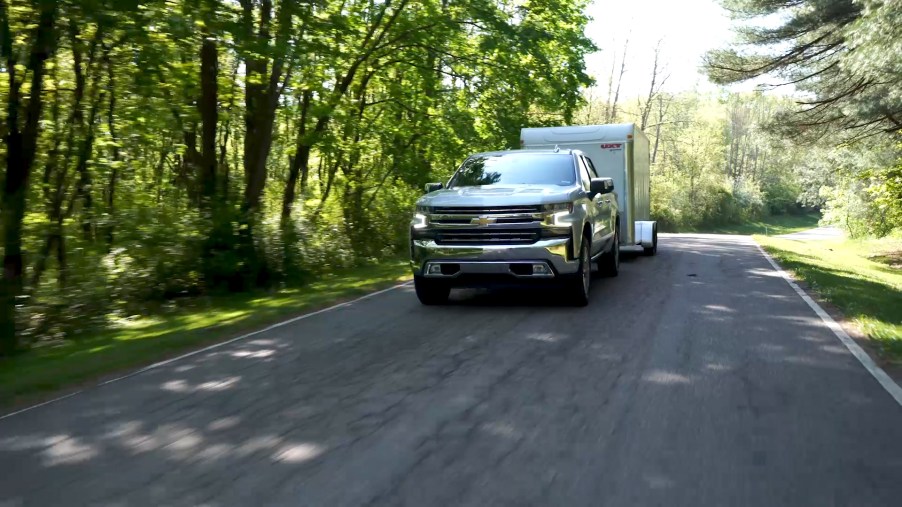
Are Chevy Trucks Made in Mexico or America?
Pickup trucks may be closely tied to the image of ‘America’, but not every ‘American’ truck is made here. And, to be fair, the nature of automotive manufacturing means truck-building a truly global task. Japanese companies like Honda and Toyota make some vehicles here in the US, for instance. It’s all a matter of economics and logistics. But even so, you might expect a truck as classically American as the Chevrolet Silverado to be made in the US, right? The truth is, many Chevy trucks aren’t made in America but in Mexico.
Chevrolet Silverado: an American icon partially made in Mexico
Two GM-brand pickups are made outside of the US: the Chevrolet Silverado and the GMC Sierra. The crew cab and regular cab versions of the Silverado and Sierra 1500 are assembled at GM’s Silao, Mexico plant. The Silao plant is one of three that GM uses to produce pickups, as The Spokesman-Review details: the other two are in Flint, Michigan and Fort Wayne, Indiana. GM’s Oshawa, Canada plant briefly made the previous-gen Silverado and Sierra.

Although GM is now the top automaker in Mexico, according to The Spokesman-Review that isn’t all due to pickup production in Silao. In fact, an unnamed GM spokesman stated that GM hadn’t added plant capacity in Mexico in a decade. GM as the top Mexican automaker has as much to due with total production as it does with Nissan cutting production. However, of the over 800,000 vehicles GM made in Mexico last year, based on a Reuters report, roughly half were pickups from Silao.
And that is starting to pose problems.
Why the Silverado’s Mexican manufacturing caused problems
One of the motivating factors behind the recent UAW strikes was Mexican manufacturing. Although production in Mexico is brisk, the strikes were sparked in part by GM closing several plants in the US and Canada. In particular, the Lordstown, Ohio plant that is now being used for electric truck manufacturing.
During the Great Recession, the union let GM keep production in Mexico so the company could stay afloat financially. But now, even with healthy profits, GM still closed American and Canadian plants. Thus, the strike. The UAW had argued that GM could have saved the Lordstown plant and others from closure by moving production back to the US. Unfortunately, as Vox reported, this was not something GM would concede over.
Why the Chevy truck Mexican plants could cause problems in the future

But, the decision to keep some pickup production in Mexico carries its own risks. Yes, Mexico currently has much lower costs of labor than the US or Canada, which is why GM is building the Silverado and Sierra there. However, this technically makes them vehicles made outside of the US, despite being made by an American company.
As such, these Chevy and GMC trucks would have been subject to ‘chicken-law’ taxes if President Trump’s attempt at imposing tariffs on Mexico had gone through. At the moment, as Jalopnik reported, the negotiation period on tariff proposition has elapsed. But that doesn’t mean the Trump administration couldn’t raise these headaches again. And if they do, a rise in price might make GM-brand loyalists jump ship.
In addition, as the UAW strike demonstrated, the Mexican plants aren’t immune to problems in Michigan. As The Drive reported, these and other plants use parts made in union plants. But the Mexican plants aren’t union. So, if the parts stop coming in because of a strike, all those workers are getting laid off. And speaking as the child of an automotive worker, that’s far from a pleasant vacation.
What are the most American-made pickups?

According to Cars.com, based on a combination of parts origin, final assembly location, and number of factory-employed Americans, the most American pickup is the Honda Ridgeline. In fact, in the list of top 15 American-made vehicles, it placed third.

Ironically, two other GM pickups also made the list. Placing 6th and 7th, respectively, were the Chevrolet Colorado and GMC Canyon. Both are assembled in GM’s Wentzville, Missouri plant. The other two pickups on the list were the Ford F-150 (#13) and the Toyota Tundra (#15).


